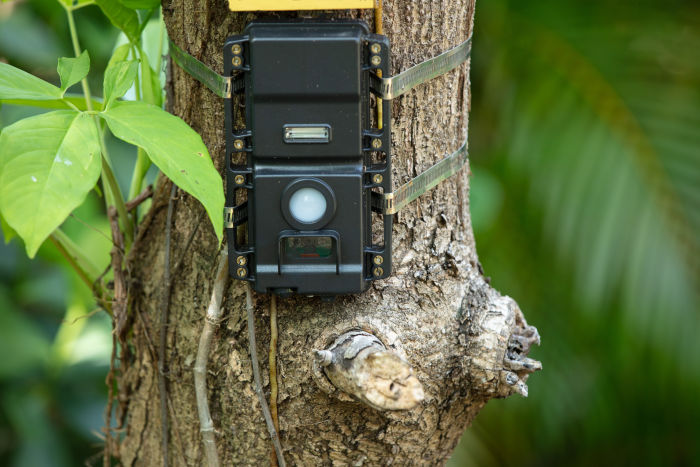How do you objectively measure the biodiversity of an environment? We spoke to Acorn’s remote sensing specialist, Sebastian Paolini van Helfteren, about birds, bioacoustics, and the great potential of this nascent technology.
How to get data for a song
First things first: while the technology detailed in this blog shows great promise, we’re still in the early stages of investigating their application.
“We’re looking to collaborate with Wageningen University as well as Rabobank's Tech Lab to explore the possibilities,” Sebastian explains. “There are different ways of measuring biodiversity, so it’s all about investigating what could work. Currently, to gather objective data on biodiversity, you need people to travel to the area — which is both complicated and expensive, so we’re trying to find a way to ensure objectivity that’s more cost-effective.”

Remote sensing: the value of a bird’s eye view
One such method might be remote sensing — something we’re already using at Acorn to measure and validate increased biomass from agroforestry, and now exploring with regards to measuring biodiversity. There have already been several pilots involving satellite images.
Adds Sebastian: “Satellites can give us insight into the vegetation's structural and functional features and variables that help us get a better view of the make-up of the environment. It’s not as if we’re able to count individual animals, but we're probably able to identify specific tree species already.”
Bioacoustics: mic’d up macaws
Then there’s bioacoustics, a relatively new approach that takes animal sounds to explore the biological makeup of an environment. “You don’t have to focus on birds for bioacoustics — you could examine insect sounds too,” Sebastian says. “It's just a matter of choice. Much like insects, birds can be key species: their presence indicates both the presence of their natural predators and the food sources that they themselves rely on, as well as the plants that those food sources imply. They can fill very specific ecological niches.”
And, of course, birds come with another bioacoustics-related benefit. “Different birds make different sounds,” Sebastian says, “so with enough data, you can train models to recognize which birds are represented in a recording. But obviously, you need a massive amount of data for that — and for many kinds of sensors, you still need to retrieve the recordings that they gathered manually.”

Camera traps: close-ups on critters
A tried and tested method, however, is the use of camera traps. Sebastian explains how these can assist in measuring biodiversity: “Camera traps are triggered when something passes it. That can be useful for gathering data on macrofauna, like mammals and such. But getting the data from those cameras can be an issue, if you still need to send someone to the location to pick up an SD card — especially if it’s an area that’s difficult to get to or traverse.”
The benefits of cameras are clear as well, though: camera traps are designed to be sturdy and can withstand quite a bit of wear and tear. On top of that, cameras are better at not just observing but identifying wildlife — something that's becoming increasingly important in the field of biodiversity. "They can, for example, identify stripe patterns in mammals, so you know exactly which tiger you're looking at," Sebastian explains.

It's not the having, it’s the getting
Clearly, an important challenge to overcome is getting the data required to analyze biodiversity. “One way to do that is using LoRa, which is short for Long Range,” Sebastian says. “It’s a kind of battery-operated, low-power radio technology that connects recording devices to, for example, satellites for long-distance transmission. But its narrow bandwidth means you can’t send entire audio files.”
Still, there are ways to handle that too: “One solution is to use edge computing in the field: to process the recordings right there before transmitting only the relevant data, but that requires more energy, so then you’re looking at solar panels and the like to facilitate that.”
Two birds with one stone?
At Acorn, our primary goal has always been to empower smallholder farmers to build climate resilience, improve their livelihoods, and increase their financial security. Agroforestry and access to the voluntary carbon market are our chosen approach, but these have other benefits as well: increased biodiversity is one of them. As Sebastian summarizes: “Acorn’s methodology can realize more than just carbon sequestration. It can contribute to more biodiversity when it comes to fauna as well as flora.”
That's why, together with Wageningen University & Research, Acorn is developing a plan to take different areas (agroforestry plots ranging in maturity, as well as non-agroforestry plots and natural forests as a baseline) in which to set camera traps for one month of the year. Repeating this for multiple years should yield valuable data, and even provide the opportunity to test LoRa in some places to see whether its application is practical.
After all, our planet’s ecosystem is meant to be rich and varied and thrives through differentiation. When our activities help foster biodiversity in threatened ecoregions, and our technological methodology enables us to objectively measure the results, we’re not hitting two birds with one stone: we’re bringing two birds to one biome.
About Acorn
We help support smallholder farmers in developing countries transition to agroforestry. Together with local partners, we facilitate the funding and training needed by farmers to start their agroforestry transition. Transforming the sequestered CO2 through agroforestry into Carbon Removal Units (CRUs), we offer carbon credits to responsible corporates to help them reach their climate goals. The growth of the trees is measured with satellite imagery, AI, and LiDAR, and certified by ICROA-accredited Plan Vivo.
With 80% of the sales revenue going directly to the farmers, it creates an additional income stream and helps them adopt a more climate-resilient way of farming that improves food security, biodiversity, and financial independence.
Get involved with Acorn
